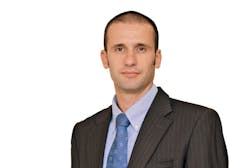Interview: Eran Eshed, Co-Founder, Altair Semiconductor
NF: Long Term Evolution (LTE) is becoming the dominant cellular-communications technology being used by devices in the US. Obviously, the industry has gotten over the initial hurdles. What issues stand in the way of full-scale deployment?
EE: This is primarily a matter of time. The competitive dynamics are such that once one significant carrier starts deploying and achieves meaningful coverage, other carriers respond. The obvious example is the way that AT&T responded to Verizon Wireless’ aggressive LTE launch. Deploying cellular infrastructure is a capital-intense process and, even logistically, it takes time. I am very much encouraged by the pace at which leading carriers deploy LTE infrastructure in their respective markets. To note a few, there are Verizon Wireless and AT&T in the US; DoCoMo and Softbank in Japan; SKT and KT in Korea; Yota in Russia; and Reliance Industries soon in India. This represents a potential subscriber base of more than 1 billion before the end of this year.
NF: Having sold your chip to Verizon, you have unique insight into these networks. Beyond meeting the needs of today’s data-hungry consumers, what do carriers hope to achieve with their increased capacity?
EE: To clarify, we achieved Verizon Wireless chipset certification. This means that any Altair customer that wishes to develop and deploy a product on the Verizon LTE network has a simpler and lower cost of doing so than before—and in comparison to alternative solutions, which are not yet certified. We will soon start seeing new services, such as HD voice-over-LTE (VoLTE) and video broadcast (using LTE’s eMBMS feature), as well as various multimedia services like high-quality video calling. Note that the push toward blanket-covering markets with LTE is not only driven by capacity needs, but also by the desire to re-farm 3G spectrum in favor of 4G. Doing so will lower the cost per bit and substantially enhance user experience by means of higher speeds, lower latency, and better quality.
NF: How do additional services, such as medical applications like remote monitoring and the management and control of smart homes, factor into these plans?
EE: The machine-to-machine (M2M) segment has high growth potential for LTE. Most M2M services today are delivered over old second-generation (2G) networks (GPRS/EDGE and CDMA). As carriers shut these networks down, they migrate their customers onto LTE. This provides better cost/efficiency while ensuring service longevity. These factors are very important parameters for M2M customers that deploy a network of sensors, for example, and want to avoid the costs associated with truck roles for replacing them when carriers power off their 2G/3G networks.
NF: What do you believe are the biggest issues still facing operators in the US?
EE: A year ago, I would answer spectrum availability. But this doesn’t seem to be a problem since AWS spectrum has been auctioned. And LTE’s ability to bond narrow bandwidth channels into one logical and higher-bandwidth channel (“carrier aggregation,” in LTE terminology) ensures that even non-contiguous and narrowband spectrum can be fully utilized. At the end of the day, this is a CAPEX question—and its answer will help to determine the pace of deployment and coverage.
NF: Looking at other countries and regions rolling out 4G, are they plagued by similar problems or different ones?
EE: LTE has a very fragmented band map. In markets that cannot guarantee an attractive enough return on investment for infrastructure and device vendors, the pace of deployment may be slower. This is not a factor of chipset capability. For a device maker to invest in creating a product variant that supports a certain band combination, a minimum volume is required.
NF: Carriers now want to offer the smartphone to more budget-constrained customers so that they too will start using new data services. How can smartphones be made less expensive?
EE: The key here is to remove 2G/3G support from these phones and make them LTE-only. This will eliminate the very high costs associated with silicon—and maybe more importantly, the royalty cost of 3G technologies. This, of course, requires good enough coverage and the ability to roam between markets. We believe we will start seeing this become a reality in 2015 and beyond.
NF: Does Altair plan to help with this goal?
EE: Absolutely. Our strategy is centered on offering high performance and very cost-efficient LTE-only semiconductor solutions. A smartphone based on Altair technology and without support for 3G can achieve disruptive price points. We are bringing this concept to bear in markets like India, where cost is paramount.
NF: Altair has a rather storied history. I read that your management and technology executives were among the founding team of Libit Signal Processing. That fabless chip company was acquired by Texas Instruments in 1999 for $365 million. Can you explain to me how you got from there to Altair Semiconductor?
EE: The core team of Altair was always somehow involved in broadband-communications chip development. As a team—and under different companies—we developed more than six broadband-communications technologies from concept to mass production and more than 40 different modem and radio chipsets over the course of the last 15 years. In 2005, we identified the emerging trend of mobile broadband. We decided to start our own company to realize the potential of this market. We then developed a chipset processor, which was software-centric and allowed us to develop three different 4G technologies without having to spin the chip. We started with WiMAX, but quickly realized that the world was going LTE. Since 2006, we have been focusing on this market.
NF: Which key executives have been with the company through all of these iterations?
EE: We are very proud to have almost all senior-level management with us from day one to today. Our management is very enthusiastic and committed to what we are trying to achieve, which has helped us get through some bumps in the road in the past.
NF: Your headquarters is in Israel, correct? I suppose that is more proof that success in the cellular market doesn’t depend on an address in Silicon Valley?
EE: Israel is a hub of immense talent in the technology space—and specifically, in the wireless-communications space. We built a team of passionate and professional individuals, who are fully committed to the success of the company and to the vision that we outlined. Over the years, we’ve established sales offices in the US, China, India, Japan, Europe, and Taiwan.
NF: To succeed in the handset market, a chipmaker has to stay ahead of its competition in price, performance, size, etc.—while its competitors try everything they can to overtake it. What do you consider Altair’s strong points, which allow it to stay in the lead?
EE: When it comes to LTE-only chipsets (i.e., without 2G/3G), we believe we have one of the highest-performing modems in the market with unmatched power consumption and—no less important—the smallest silicon die in the market. So we are well positioned to cope with the erosion in LTE-chipset average selling prices (ASPs). We also have a very competitive roadmap. We just announced two baseband processors and a radio chip, which we believe are two steps ahead of the competition.
NF: When do you expect LTE-Advanced (LTE-A) chipsets to begin being designed into smartphones and other devices?
EE: We just announced a couple of LTE-A-capable chipsets, which will be in mass production before the end of this year. I believe you will see devices based on these chipsets in the market in 2014.
NF: What challenges must be overcome for the successful adoption of LTE-A?
EE: Power consumption is a major challenge as speeds increase and the amount of processing required from the communications engine grows dramatically. We believe our unique processor architecture will allow us to overcome this challenge and offer 10X higher LTE speeds at comparable power consumption to existing 3G. This is essential for the user experience, which cannot degrade as technology evolves.
NF: How do you think LTE-A will change the landscape in terms of available capacity and new applications?
EE: This is a good question. LTE-A’s main driver appears to be capacity rather than speed and quality of service. Fifteen years ago, we thought dial-up was more than enough. Here we are today, talking about applications that will consume much more than 100 Mb/s. I think it is difficult to predict what applications and services will make use of such immense bandwidth. I am pretty sure, though, that these capabilities will be leveraged in whole.
NF: Do you expect Altair to enjoy more growth in 2013? What trends do you foresee in the semiconductor market in general?
EE: Absolutely. Until now, our growth was hampered by the moderate pace at which LTE networks were deployed and the lack of sufficient coverage to support LTE-only service. This is rapidly changing. With key carriers like Verizon Wireless achieving coverage parity with 3G, we expect to enjoy significant growth in shipments to this market sometimes referred to as the “Internet of Things.” We are targeting the next billion connected devices.
About the Author

Nancy Friedrich
RF Product Marketing Manager for Aerospace Defense, Keysight Technologies
Nancy Friedrich is RF Product Marketing Manager for Aerospace Defense at Keysight Technologies. Nancy Friedrich started a career in engineering media about two decades ago with a stint editing copy and writing news for Electronic Design. A few years later, she began writing full time as technology editor at Wireless Systems Design. In 2005, Nancy was named editor-in-chief of Microwaves & RF, a position she held (along with other positions as group content head) until 2018. Nancy then moved to a position at UBM, where she was editor-in-chief of Design News and content director for tradeshows including DesignCon, ESC, and the Smart Manufacturing shows.
